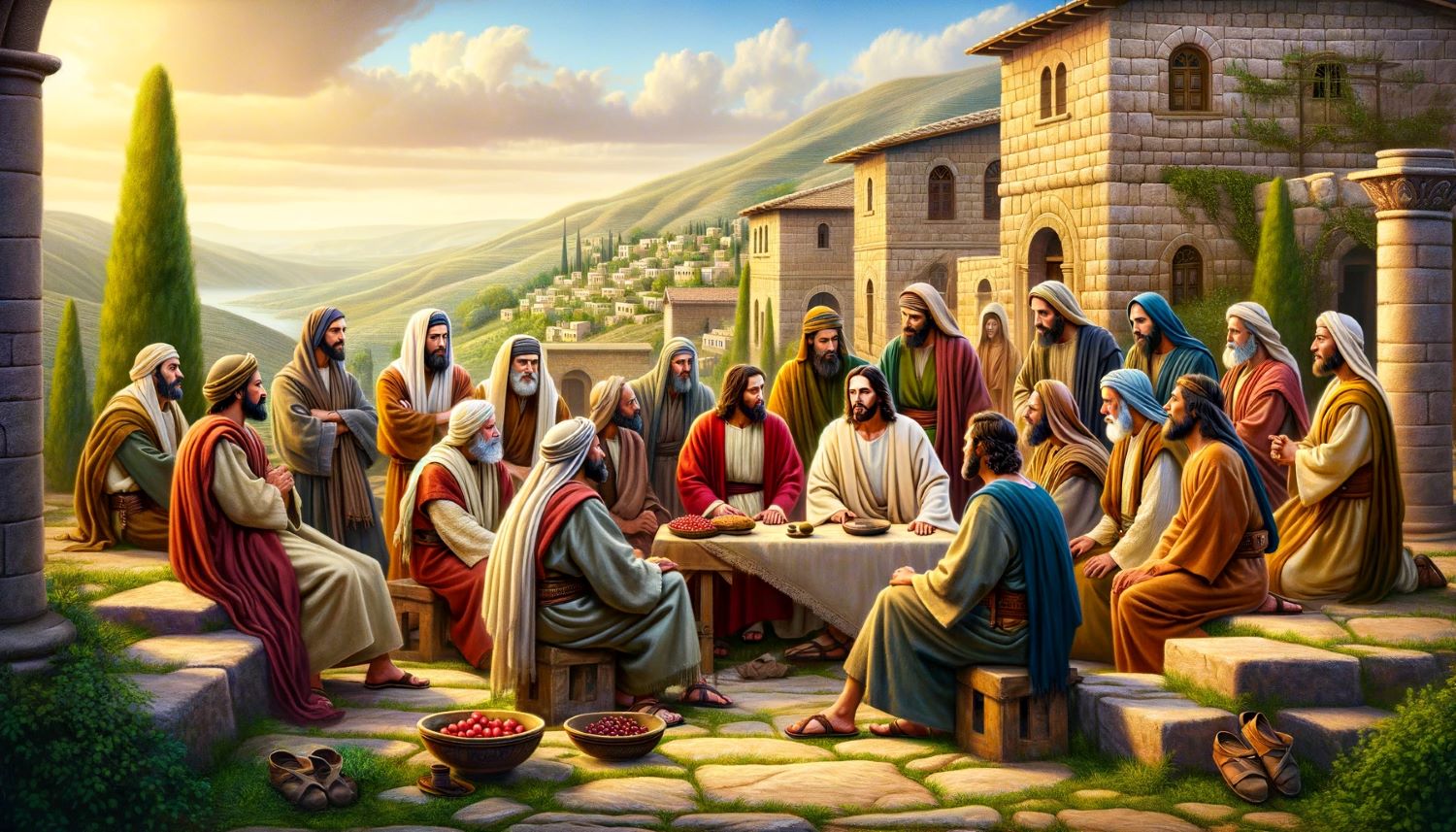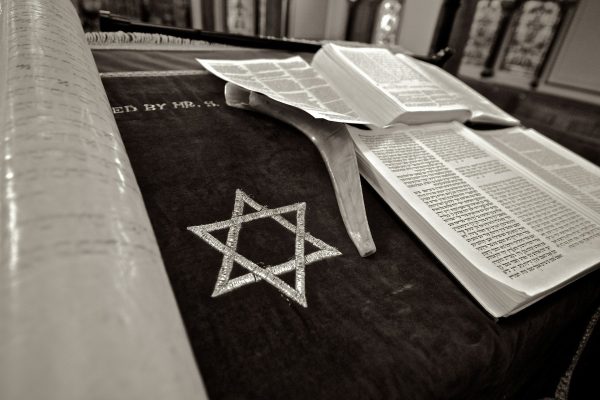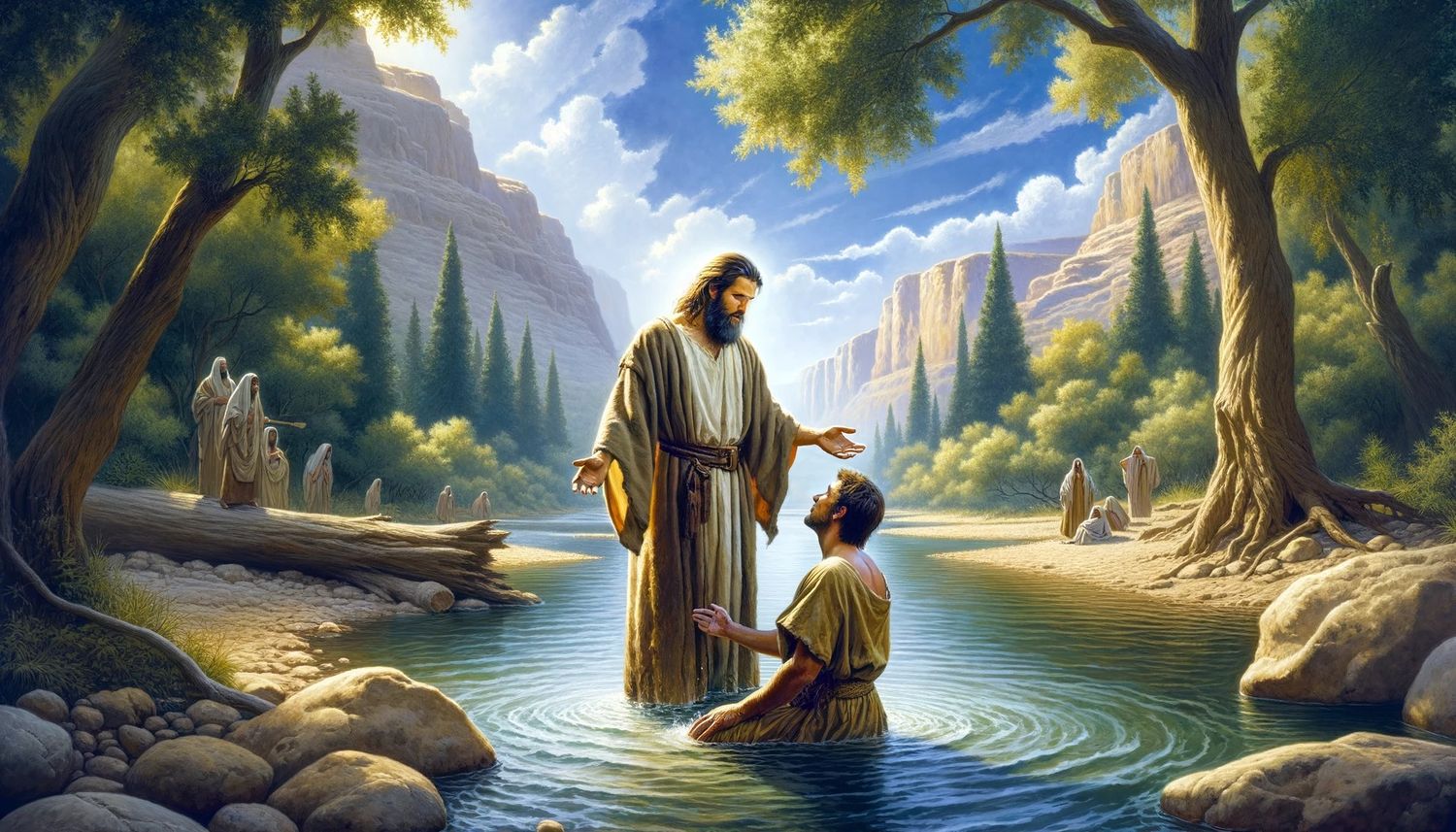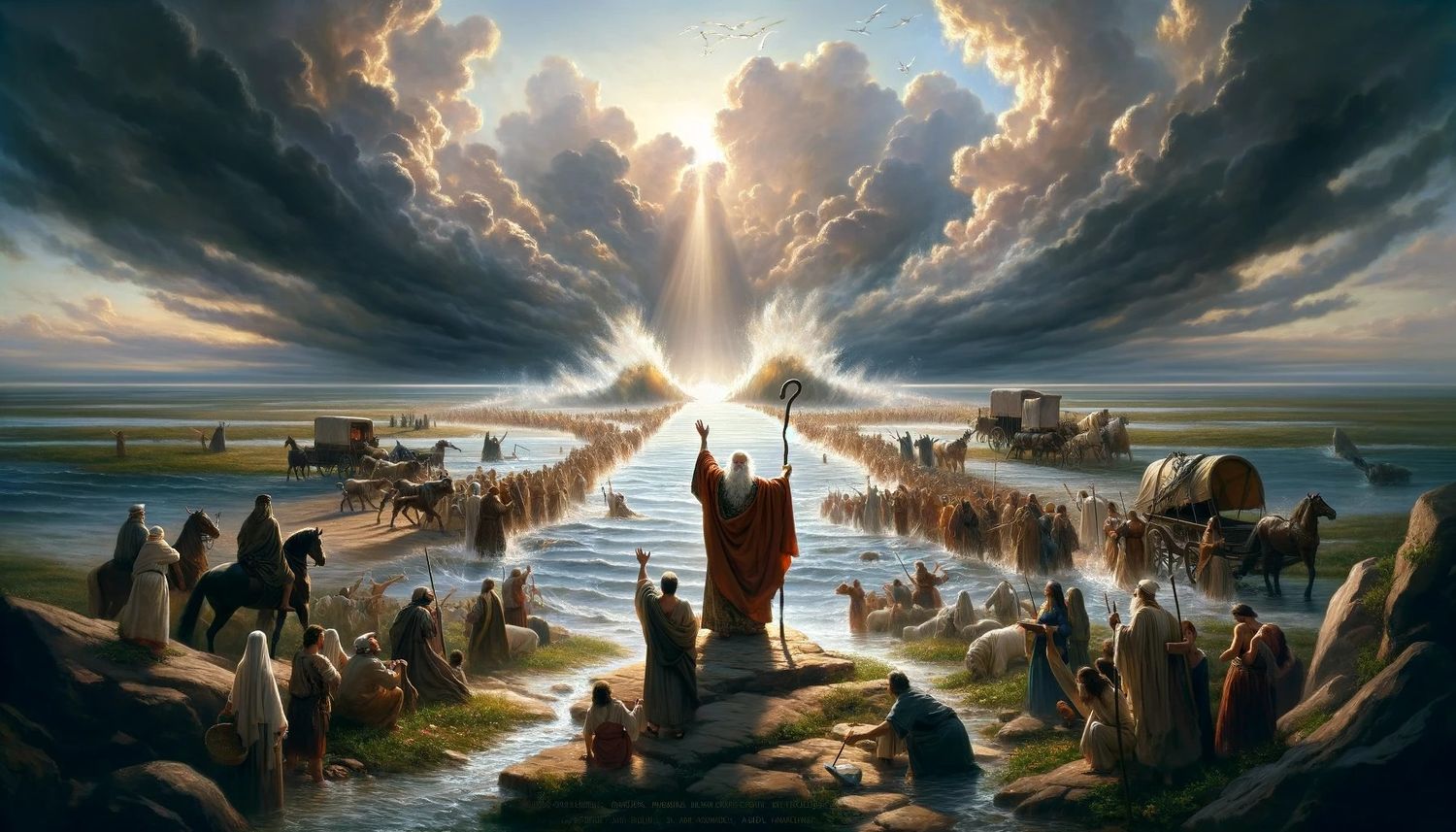Home>Theology and Spirituality>What Is Jewish Baptism


Theology and Spirituality
What Is Jewish Baptism
Published: February 29, 2024
Jason DeRose, Managing Editor at Christian.net, uses his expertise in religion and journalism to deepen understanding of faith's societal impacts. His editorial leadership, coupled with a strong academic background, enriches the platform’s diverse content, earning him recognition in both journalism and religious circles.
Discover the significance of Jewish baptism and its role in theology and spirituality. Explore the traditions and beliefs surrounding this sacred ritual.
(Many of the links in this article redirect to a specific reviewed product. Your purchase of these products through affiliate links helps to generate commission for Christian.net, at no extra cost. Learn more)
Table of Contents
Introduction
What is Jewish baptism? This is a question that often arises when discussing the religious practices of Judaism. Jewish baptism, also known as tevilah, holds significant historical and spiritual importance within the Jewish faith. In this article, we will delve into the historical background, rituals, symbolism, and modern practices of Jewish baptism. Additionally, we will explore the comparisons and controversies surrounding Jewish baptism in relation to other religious traditions, particularly Christian baptism. Understanding the intricacies of Jewish baptism is essential for gaining insight into the rich tapestry of religious customs and beliefs within the Jewish faith.
Read more: When Is The Jewish Day Of Atonement
Historical Background of Jewish Baptism
-
Ancient Origins: The practice of ritual immersion, or tevilah, has ancient roots in Jewish tradition. It dates back to the time of the Second Temple period, around 516 BCE to 70 CE. During this era, immersion in a mikveh, a ritual bath, was a common practice for purification and spiritual renewal. This act of immersion was not only a physical cleansing but also symbolized a spiritual rebirth and a return to a state of ritual purity.
-
Biblical References: The concept of immersion for spiritual purification is mentioned in the Hebrew Bible. In the book of Leviticus, there are specific instructions regarding ritual immersion for various purposes, including after coming into contact with certain impurities. The act of immersion was seen as a way to restore spiritual wholeness and was an integral part of Jewish religious life during biblical times.
-
Talmudic Influence: The Talmud, a central text of Rabbinic Judaism, further solidified the significance of immersion in Jewish religious practice. It provided detailed guidelines for the construction and use of mikvehs, emphasizing the importance of immersion for various religious and ceremonial purposes. The Talmudic period played a crucial role in shaping the ritual of tevilah and its role in Jewish life.
-
Continued Relevance: Despite the destruction of the Second Temple and the dispersion of the Jewish people, the practice of tevilah continued to hold significance in Jewish communities around the world. It became an enduring symbol of spiritual purification, renewal, and transition, reflecting the timeless nature of Jewish religious traditions.
-
Influence on Other Traditions: The concept of ritual immersion in Judaism has also influenced other religious traditions, including Christian baptism. The historical background of Jewish baptism provides a deep well of tradition and symbolism that continues to resonate within the Jewish faith and beyond.
Rituals and Symbolism of Jewish Baptism
-
Preparation and Intent: Before undergoing tevilah, individuals engage in a period of spiritual preparation. This may involve introspection, prayer, and a reaffirmation of faith. The act of immersion is not merely a physical ritual but a deeply spiritual and intentional practice.
-
Immersion in the Mikveh: The central ritual of Jewish baptism involves immersion in a mikveh, a pool of natural water or a specially constructed ritual bath. The individual fully immerses themselves in the water, ensuring that every part of the body is touched by the purifying waters. This act symbolizes a complete spiritual cleansing and renewal.
-
Threefold Immersion: In some traditions, the individual may immerse themselves in the mikveh three times, emphasizing the significance of the act. Each immersion represents a different aspect of spiritual transformation – purification, separation from past impurities, and a renewed commitment to faith and spiritual growth.
-
Symbol of Rebirth: The act of immersion in the mikveh is often seen as a symbolic representation of rebirth. Just as a newborn enters the world in a state of purity, the individual emerging from the mikveh is metaphorically reborn, free from past transgressions and spiritually rejuvenated.
-
Transition and Transformation: Jewish baptism is not solely about purification; it also signifies a transition from one state of being to another. It marks significant life events such as conversion to Judaism, marriage, or the restoration of spiritual wholeness after a period of separation from the community.
-
Connection to Community and Tradition: Immersion in the mikveh is deeply rooted in communal and historical significance. It connects the individual to the collective experience of the Jewish people throughout history, reinforcing a sense of continuity and shared tradition.
-
Spiritual Healing and Renewal: The mikveh serves as a source of spiritual healing, offering a space for individuals to seek solace, forgiveness, and renewal. It is a tangible expression of the belief in the transformative power of faith and the opportunity for spiritual growth.
-
Elevating Everyday Acts: In some Jewish traditions, immersion in the mikveh is incorporated into various life events, such as before Shabbat or holidays, elevating these everyday acts into moments of spiritual significance. It underscores the holistic integration of faith into daily life.
The rituals and symbolism of Jewish baptism encompass a profound spiritual journey, reflecting the enduring traditions and beliefs within the Jewish faith. Each aspect of the ritual carries deep significance, emphasizing the transformative power of faith and the enduring connection to Jewish heritage and community.
Comparison with Christian Baptism
-
Theological Significance: While both Jewish baptism and Christian baptism involve ritual immersion, they carry distinct theological meanings. In Christian baptism, the act symbolizes the cleansing of original sin and the initiation into the body of Christ. It represents a spiritual rebirth and the forgiveness of sins through the acceptance of Jesus Christ as savior. On the other hand, Jewish baptism, or tevilah, emphasizes spiritual purification, renewal, and transition within the context of Jewish faith and tradition.
-
Mode of Immersion: In Christian baptism, immersion may be full-body immersion, affusion (pouring), or aspersion (sprinkling), depending on the denomination and theological beliefs. However, immersion in water is central to many Christian baptismal practices. In contrast, Jewish baptism specifically entails immersion in a mikveh, a ritual bath, with a focus on the complete submersion of the body in natural water as a symbol of spiritual cleansing and renewal.
-
Symbolism of Sin and Redemption: Christian baptism is often associated with the remission of sins and the acceptance of Jesus Christ as the redeemer. It signifies a spiritual transformation and the washing away of sin through faith in Christ. In Jewish baptism, the emphasis is on spiritual purity, transition, and the restoration of wholeness within the framework of Jewish religious life. The symbolism of sin and redemption carries distinct interpretations within each tradition.
-
Sacramental Differences: Christian baptism is considered a sacrament in many Christian denominations, signifying a sacred rite that imparts divine grace. It is often accompanied by specific liturgical rituals and prayers. In contrast, Jewish baptism, while holding deep spiritual significance, is not viewed as a sacrament in the same theological sense within Judaism. The focus is on the individual's connection to Jewish tradition and the community, as well as personal spiritual growth and renewal.
-
Historical and Cultural Context: The historical and cultural contexts of Christian baptism and Jewish baptism are rooted in different religious narratives and traditions. Christian baptism is closely tied to the life, teachings, and resurrection of Jesus Christ, as documented in the New Testament. In contrast, Jewish baptism, with its origins in the Hebrew Bible and Rabbinic literature, reflects the enduring customs and beliefs of the Jewish people throughout history.
-
Interfaith Dialogue and Understanding: Exploring the similarities and differences between Jewish baptism and Christian baptism provides an opportunity for interfaith dialogue and understanding. It allows for a deeper appreciation of the diverse theological perspectives and spiritual practices within Judaism and Christianity, fostering mutual respect and cooperation in an increasingly interconnected world.
The comparison between Jewish baptism and Christian baptism highlights the unique theological, ritual, and historical aspects of each tradition. While both practices involve ritual immersion and spiritual symbolism, they embody distinct theological narratives and cultural expressions within the broader tapestry of religious diversity.
Modern Practices of Jewish Baptism
-
Continued Relevance: In contemporary Jewish communities, the practice of tevilah, or ritual immersion, remains an integral part of religious life. Individuals engage in the act of immersion for various purposes, including conversion to Judaism, preparation for marriage, spiritual renewal, and the observance of certain religious laws and customs. The enduring relevance of tevilah reflects its continued significance in connecting individuals to their faith and heritage.
-
Mikveh Usage: Mikvehs, the ritual baths used for immersion, are found in Jewish communities worldwide. These facilities adhere to specific guidelines regarding construction, water sources, and maintenance to ensure their ritual purity. Modern mikvehs may feature separate areas for men and women, as well as accommodations for individuals with diverse needs, emphasizing inclusivity and accessibility within the practice of tevilah.
-
Ritual Preparation: Prior to immersion, individuals partake in a period of spiritual preparation, often guided by a rabbi or spiritual mentor. This may involve study, prayer, and reflection on the significance of the upcoming immersion. The process of preparation underscores the intentional and deeply personal nature of the ritual, fostering a sense of spiritual readiness and commitment.
-
Diverse Applications: The modern practices of Jewish baptism extend beyond traditional contexts. Immersion in the mikveh is also observed in relation to life events such as childbirth, healing from illness, and spiritual transitions. Additionally, individuals may undergo tevilah as part of the process of formal conversion to Judaism, signifying a profound commitment to embracing the faith and its traditions.
-
Educational Initiatives: Many Jewish communities emphasize the educational aspects of tevilah, providing resources and guidance for individuals seeking to understand the significance of immersion within the context of Jewish law and spirituality. Educational initiatives aim to deepen the understanding of tevilah as a transformative and enriching practice, fostering a sense of connection to Jewish heritage and values.
-
Inclusivity and Diversity: Modern practices of Jewish baptism embrace the diversity of Jewish identity and experience. Immersion in the mikveh is open to individuals from varied backgrounds, including those who identify as LGBTQ+, interfaith families, and individuals exploring their Jewish heritage. This inclusive approach reflects a commitment to honoring the spiritual journeys of all members of the Jewish community.
-
Personal and Communal Significance: Immersion in the mikveh is a deeply personal experience, yet it also holds communal significance. Individuals often share the experience of tevilah with their community, marking important life transitions and spiritual milestones. The communal aspect of tevilah reinforces the interconnectedness of individuals within the broader tapestry of Jewish faith and tradition.
-
Adaptation and Innovation: While rooted in ancient tradition, modern practices of Jewish baptism have also seen adaptation and innovation to meet the evolving needs of contemporary Jewish communities. This may include the incorporation of technology for scheduling mikveh appointments, the development of educational resources, and the establishment of outreach programs to engage individuals in the practice of tevilah.
The modern practices of Jewish baptism reflect the enduring relevance and adaptability of this ancient ritual within the diverse tapestry of Jewish religious life. As Jewish communities continue to evolve, the practice of tevilah serves as a timeless expression of faith, spiritual renewal, and connection to the rich heritage of Judaism.
Read more: How Many Of The Apostles Were Jewish
Controversies and Debates Surrounding Jewish Baptism
-
Interfaith Dialogue: One of the ongoing debates surrounding Jewish baptism revolves around its comparison with Christian baptism. Some scholars and religious leaders engage in interfaith dialogue to explore the theological and ritual differences between the two practices. This dialogue aims to foster understanding and respect for the distinct traditions of Jewish and Christian baptism, while also addressing potential areas of theological tension and misinterpretation.
-
Theological Interpretations: Within the Jewish community, there are varying theological interpretations regarding the significance of tevilah and its application in modern religious life. Debates may arise concerning the specific requirements for immersion, the role of intention and spiritual preparation, and the broader theological implications of the ritual. These discussions contribute to a deeper exploration of the diverse perspectives within Judaism regarding the practice of tevilah.
-
Inclusivity and Gender Equality: Controversies surrounding the practice of Jewish baptism also intersect with issues of inclusivity and gender equality. Some debates focus on the accessibility of mikvehs for individuals of diverse gender identities and the recognition of LGBTQ+ individuals within the ritual of tevilah. These discussions prompt reflection on how the practice of tevilah can be inclusive and affirming for all members of the Jewish community.
-
Conversion and Identity: The process of conversion to Judaism and the role of tevilah in formalizing one's Jewish identity can be a topic of debate within Jewish communities. Discussions may center on the requirements for immersion as part of the conversion process, the acceptance of individuals from diverse cultural backgrounds, and the preservation of Jewish tradition while embracing new members. These debates reflect the complexities of identity and belonging within the context of Jewish baptism.
-
Historical and Cultural Preservation: Controversies may arise regarding the preservation of historical and cultural practices related to tevilah. As Jewish communities evolve, discussions may focus on balancing the adaptation of the ritual to contemporary needs while honoring its ancient traditions. The tension between preservation and adaptation underscores the ongoing dialogue surrounding the cultural significance of Jewish baptism.
-
Legal and Ethical Considerations: In some regions, legal and ethical considerations regarding the use of mikvehs and the practice of tevilah have sparked debates within Jewish communities. These discussions may encompass issues such as public health regulations, the oversight of ritual immersion facilities, and the protection of individual rights in relation to the practice of tevilah. Addressing these considerations involves navigating the intersection of religious freedom, public policy, and communal well-being.
-
Secular and Religious Perspectives: Controversies surrounding Jewish baptism also extend to the interface between secular and religious perspectives. Debates may arise regarding the recognition of tevilah within secular legal frameworks, the role of the ritual in personal spiritual practice, and the broader implications of religious rituals in a diverse and pluralistic society. These discussions highlight the multifaceted nature of the debates surrounding Jewish baptism.
-
Interpretation of Sacred Texts: Disagreements over the interpretation of sacred texts related to tevilah, including passages from the Hebrew Bible and Rabbinic literature, can contribute to debates within the Jewish community. These debates may focus on the historical context of the ritual, the evolution of its practice, and the application of traditional teachings to contemporary religious life. Engaging with sacred texts forms an integral part of the ongoing debates and interpretations surrounding Jewish baptism.
The controversies and debates surrounding Jewish baptism reflect the dynamic and multifaceted nature of religious discourse within the Jewish community. These discussions encompass theological, cultural, ethical, and legal dimensions, contributing to a deeper understanding of the complexities and significance of the ritual of tevilah within the diverse tapestry of Jewish religious life.














